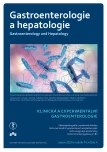Iron substitution in sideropenia or sideropenic anemia in patients with IBD with heme iron containing preparation
Authors:
Vašátko M. 1; Pešinová V. 1; Malíčková K. 1; Machková N. 1; Hrubá V. 1; Lukáš M. 1; Kolář M. 1; Lukáš M. 1,2
Authors‘ workplace:
Klinické a výzkumné centrum pro idiopatické střevní záněty ISCARE a. s., Praha
1; 1. LF UK v Praze
2
Published in:
Gastroent Hepatol 2020; 74(4): 361-365
Category:
doi:
https://doi.org/10.14735/amgh2020361
Overview
Introduction: Sideropenia and sideropenic anemia occurring in more than a half of patients suffering from inflammatory bowel disease (IBD). The efficacy in replenishing of the iron storage or therapy of sideropenic anemia is part of the national guidelines for IBD population. Unfortunately, in IBD patients, therapy with inorganic iron preparations is associated with intolerance or side effects which occurred relatively often.
Methods and results: A cohort of 43 IBD patients without inflammatory activity (31 with Crohn’s disease and 12 with ulcerative colitis) with sideropenia (ferritin level < 30 µg/L) or mild sideropenic anemia (hemoglobin 100 g/L–120 g/L) were recruited for 12 weeks therapy with GlobiFer®forte tablet containing heme iron and also inorganic iron. The median hemoglobin concentration significantly increased from week 0 to week 12 (123.5 g/L to 133.5 g/L) (P = 0.004) and median mean red cell corpuscular volume changed from 85.2 fL at week 0 to 87.3 fL at week 12 (P = 0.05). GlobiFer®forte was very well tolerated and side effects occurred only in one patient.
Conclusion: The heme iron which is part of GlobiFer®forte was very well tolerated and this therapy led to the normalization of hemoglobin concentration and mean red cell volume at the end of the therapy.
Keywords:
inflammatory bowel disease – heme iron – sideropenia – sideropenic anemia
Sources
1. Bayraktar UD, Bayraktar S. Tretament of iron deficiency anemia associated with gastrointestinal tract diseases. World J Gastroenterol 2010; 16 (22): 2720–2725. doi: 10.3748/wjg.v16.i22.2720.
2. Lukáš M. Hemové železo v substituci sideropenie a sideropenní anémie. Gastroent Hepatol 2019; 73 (3): 271–272. doi: 10.14735/amgh2019271.
3. GlobiFer forte: Příbalový leták o přípravku.
4. Slíva J. Železo a jeho využití v organismu. Remedia 2013; 23 (5): 254–257.
5. Hrdlička L, Kohout P, Liberda M et al. Doporučený postup pro diagnostiku a léčbu anémie u IBD. Gastroent Hepatol 2012; 66 (4): 280–285.
6. Barragán-Ibañeza G, Santoyo-Sánchez A, Ramos-Peñafiel CO. Iron deficiency anaemiaAnaemia por deficiencia de hierro. Revista Médica del Hospital General de México 2016; 79 (2): 88–97. doi: 10.1016/j.hgmx.2015.06.008.
7. Slíva J. Suplementace železem: na formě záleží. [online]. Dostupné z: http: / / wp.interna-cz.eu/ suplementace-zelezem-na-forme-zalezi.
Labels
Paediatric gastroenterology Gastroenterology and hepatology SurgeryArticle was published in
Gastroenterology and Hepatology

2020 Issue 4
- Metamizole at a Glance and in Practice – Effective Non-Opioid Analgesic for All Ages
- Metamizole in perioperative treatment in children under 14 years – results of a questionnaire survey from practice
- Obstacle Called Vasospasm: Which Solution Is Most Effective in Microsurgery and How to Pharmacologically Assist It?
- Possibilities of Using Metamizole in the Treatment of Acute Primary Headaches
- Metamizole vs. Tramadol in Postoperative Analgesia
Most read in this issue
- EUS-guided gastrointestinal anastomosis – new possibilities of therapeutic endoscopy
- Jorveza® – the expected preparation for the treatment of eosinophilic esophagitis
- Whipple disease – two case reports
- Portopulmonální hypertenze u pacientů indikovaných k transplantaci jater – zkušenosti transplantačního centra IKEM
